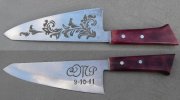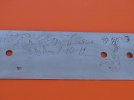- Joined
- Dec 2, 2011
- Messages
- 111
Reading David Boye's book Knifemaking You can do it I finally got to the chapter about etching. Is anyone here an "Etcher"? I see reference to etching Damascus but I think that's different as Im thinking there is no masking or use of "grounds" or "resist". In the book there are quite a few pictures of some really elaborate and quite beautiful etchings. Can stencils be used though the artist who did the knives in the book appears to be doing it freehand. Two names mentioned were Jessie Oster and Joyce Sierra. I suppose I'll get some materials and see what comes of it.


